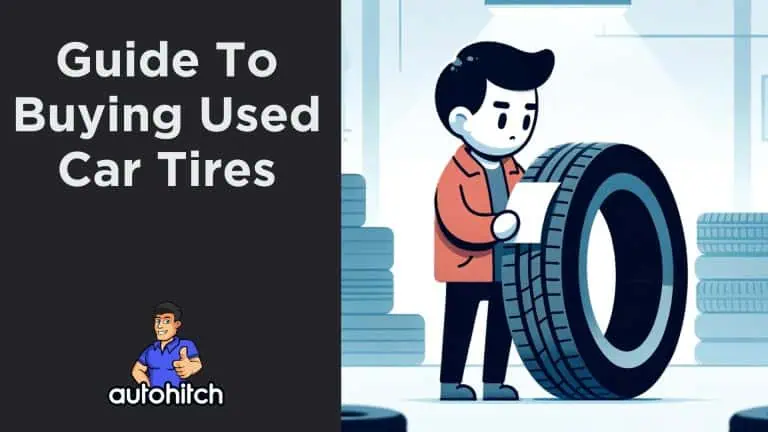Looking to save money on new tires for your car?
Buying Used Tires offers potential cost savings of 30-50% or more compared to new tires. I myself frequently bought used cars when I ran my small dealership.
However, there are risks involved with used tires that you must weigh carefully.
Using my years of experience buying used tires, I created this comprehensive guide that covers everything you need to know about buying used car tires.
We’ll look at the pros and cons, where to buy used tires, how to inspect them, average pricing, and much more.
Key Takeaways on Buying Used Tires
Here are the most critical points to understand upfront if considering used tires:
- Significant cost savings – Used tires can retail for half the price or less than new ones.
- Safety hazard – Used tires fail more often and have risks like unseen damage. Tread depth, age, and wear patterns must be checked.
- Shorter lifespan – The tread won’t last as long as new tires, requiring earlier replacement.
- Careful inspection is essential – Thoroughly checking used tires inside and out for any flaws is critical before purchasing. An expert can assist.
- Stick with reputable sellers – Trustworthy local shops and online retailers help mitigate risks of used tire purchases compared to random sellers.
Keep reading for more details in each area to make the safest, most informed decision on whether used tires suit your needs and budget.
Relevant Articles to Read:
Table of Contents
Why Buy Used Tires? Cost Savings and Environmental Benefits
The biggest motivation most drivers have for purchasing used tires rather than new ones comes down to price.
- Quality used tires can retail for roughly half the cost or less than buying new. With new car tires ranging from $100 on the low end to $300+ for premium performance tires, doubling your tire budget makes a big difference!
- Even with less tread depth, used tires offer comparative value in terms of functional mileage left derived from the cheaper upfront cost.
Of course, it depends on finding the right deal from a reputable seller – we’ll cover that shortly.
An added bonus is that reusing tires keeps them out of landfills. New tire manufacturing and materials waste takes a heavy environmental toll. So, buying used tires aligns well with eco-friendly values.
What Impacts Used Tire Pricing?
Several variables impact what used tires will cost you:
- Original retail price – Higher-end tire models hold value better
- Tire type – Performance tires typically more than standard all-seasons
- Tread depth – More tread means higher prices
- Brand – Major brands cost more than lesser known ones
- Overall condition – No damage or repairs needed commands better pricing
- Age – Younger tires in higher demand.
- Quantity – Bulk purchases often discounted
As a general rule, expect to spend $25 to $100 per tire when buying used. Very premium or specialty tires in great shape with deep tread can exceed $100. Cheaper passenger tires tend closer to the $25 range when more worn.
Installation also adds $15 to $50 per tire in mounting/balancing costs unless a tire shop includes it free with purchase.
Here are some real-world used tire price ranges based on consumer search data:
| Tire Category | Used Tire Price Range |
|---|---|
| Passenger Tires | $25-$160 per tire |
| SUV Tires | $37-$403 per tire |
| Truck Tires | $34-$197 per tire |
| High-Performance Tires | $30-$1,000+ per tire |
| Motorcycle Tires | $5-$100 per tire |
Pricing varies widely, but this gives an idea of typical used car tire costs. With new tires easily $125+ each for passenger cars and SUVs, the savings appeal.
Should You Buy Used Tires? Benefits vs Risks
Are used tires right for your vehicle? Consider the advantages and disadvantages.
Benefits of Used Tires
Cost savings – As outlined already, used tires offer significant upfront savings over tires. Even with less tread depth, the relative value holds up.
Environmental benefit – Reusing tires keeps 30+ million tires annually from landfills in the US alone. New tires have a staggering carbon footprint through raw materials waste.
Availability of tread patterns – The huge used tire market provides more selection in brands, models, and designs over what local new tire shops carry. Specialty wheel fitments can be found affordably.
Risks of Buying Used Tires
Safety – Used tires have over triple the failure rate of new tires and cause thousands of accidents annually. Damage from use or improper storage stresses the rubber compounds over time. Unseen internal weakness leads many blowouts.
Uncertain history – It is almost impossible to know objectively how well-maintained a used tire was or any issues encountered before you. Even detailed seller disclosure leaves doubt.
Shorter lifespan – The tread depth already partially depleted brings used tires closer to end-of-life failure, requiring replacement again sooner than new tires.
No warranty – Do not expect any warranty safeguard on used tires. You assume all liability once mounted, even if flaws existed from before you bought them.
The safety concern around used tires is most worrying, evident through higher failure rates. But buying from trustworthy sources, inspecting thoroughly, and verifying key indicators minimizes risk.
Where To Buy Used Tires From Reputable Sellers
Avoiding exposure from potentially unscrupulous sellers is vital when venturing into used tire buying. Seek out these safer purchase channels:
Brick-and-mortar tire shops – Many independent dealers sell quality used take-off tires inspected to verify acceptable condition without damage. And their business reputation gives confidence. Storage matters too – showroom conditions preserve integrity.
Online markets – Major sites like eBay and Craigslist offer buyer protections and seller rating systems. Seek sellers here with high review counts and scores. Cross-reference other review sites as added due diligence where possible.
Specialized online tire retailers – Stores focused on selling used tires must invest in inventory quality to uphold their reputation. Their expertise in inspection and condition grading improves the odds of a safe purchase. TreadHunter is one such example.
Inspect seller history, facility conditions, and policies around liability and returns carefully before committing to any used tire purchase. This filters out less scrupulous operators.
Step-By-Step Used Tire Inspection Guide
Here is the tire checklist to scrutinize used tires before buying:
| Inspection Check | Details |
|---|---|
| 1. Check manufacturing date code | Locate the DOT tire code imprinted on the sidewall. The last 4 digits show the week and year made. Example: 3119 means 31st week of 2019. Avoid tires 6 years old or greater. |
| 2. Measure tread depth | Insert a penny upside down into the tread. If you see the top of Lincoln’s head, it’s too worn. Use a tread depth gauge for precision. Aim for minimum 4/32 inch. |
| 3. Look for damage | Carefully inspect inside and out for cuts, punctures, cracks, bulges, gouges, and abrasions anywhere. Even minor flaws risk hidden structural issues. |
| 4. Evaluate wear patterns | Examine the tread contact surface across the width of the tire. Avoid used tires with uneven shoulder wear or other irregular wear indicating alignment problems or damage history. |
| 5. Research past recalls | Cross reference the full tire DOT code against databases that catalog recalled tire makes/models based on safety defects detected. |
| 6. Assess repairs | Tires plugged more than once or with repairs to the sidewall or shoulder tread areas have severely weakened structural integrity. Avoid these except for emergencies. |
| 7. Consider tire age vs. condition | While 6 years old is a general cut-off, individual tire condition factors greater. A 5 year old tire with slight weathering may be fine if tread depth is good vs a 4 year old tire showing cracking from poor storage conditions. |
Ideally, have any used tires fully inspected by a trained tire technician using proper equipment. Their deeper assessment capability is worthwhile for safety.
Warning Signs of Unsafe Used Tires
Be vigilant for these specific flaws indicating underlying tire problems beyond usable life or unsafe conditions:
- Cracking in the rubber on the outer sidewalls or within tread grooves signaling advanced weather deterioration
- Irregular, uneven tread depths across the tire reveal damage or structural issues
- Patches, plugs, or other embedded repairs that undermine integrity through holes drilled in tread
- Insufficient tread under 2/32 inch, which offers almost no wet weather grip
- Air bubbles or bulges hinting at internal belt or wall separation
- Fatigue cracks inside the lower sidewall nearest the rim
- Exposed steel belt wires protruding through lost tread rubber
Tires displaying any of those Warning Signs should be immediately eliminated from consideration. The latent flaws make failure risk dangerously high in continued driving use.
Average Used Tire Tread Life Expectancy
While expected longevity fluctuates based on wear and age at the time of purchase, here are general guidelines on realistic, usable mileage estimates from used tires by tread depth remaining:
| Original Tread Range | Typical Miles Remaining |
|---|---|
| 8/32″ – 10/32″ | 15,000 – 25,000 miles |
| 5/32″ – 7/32″ | 8,000 – 15,000 miles |
| 4/32″ | 2,000 – 8,000 miles |
Keep in mind taller sidewall tires common on light trucks and SUVs will skew toward the upper end of mileage while lower profile tires show wear quicker.
Rotation every 5,000 – 8,000 miles helps distribute wear patterns evenly across used tires to maximize tread life. Alignment checks ensure straight tracking along with rotations.
The takeaway when estimating used tire longevity is that while not matching new, the lower upfront investment counters shorter usable miles appropriately.
Smart Safety Precautions with Used Tires
Given the heightened safety stakes of using older, worn tires, prudent precautions like these help reduce blowout or failure risks:
- Test drive the tires slowly first before extending highway speeds
- Keep speeds moderate, avoiding excessive speeds taxing tire structure
- Inflate used tires to max air pressure rating for load rather than minimum
- Rotate used tires more frequently to promote even tread distribution
- Verify alignment to minimize uneven wear patterns
- Clean used tires more frequently to inspect for new cracks forming
Think through your driving usage (lengths, speeds, load weights, terrain) to minimize unnecessary tire stress as an extra precaution.
Key Takeaways – Is Buying Used Tires Worth It?
Are used tires ultimately a smart money-saving investment or safety risk? Ask yourself:
✅ Do I prioritize saving money over maximizing the life span of tires? Used tires get you substantial upfront savings but don’t last as long.
✅ Does my driving usage stay relatively low speed and moderate mileage? More cautious duty cycles reduce failure risks with used rubber.
✅ Can I have the tires inspected in advance properly? Vetting conditions before purchase is key to limiting safety hazards.
If you answered yes to those questions and buy smart through a vetted seller, inspect diligently upfront, and remain conservative in driving usage – then used tires likely suit your needs and budget well.
Sources For this Article:
- My personal experience as a licensed car dealer
- https://autoily.com/how-much-are-used-tires/
- https://www.tirecomp.com/suv.htm
- https://www.utires.com/t/v-light-truck/
- https://tirehungry.com/used-tire-cost/
- https://www.reddit.com/r/Frugal/comments/jubwi0/whats_the_problem_with_used_tires/?rdt=54398
- https://www.consumerreports.org/tires/how-to-assess-tires-on-a-used-car/
- https://www.reddit.com/r/askcarsales/comments/171zfqh/what_is_your_dealerships_recon_policy_with_a_used/
- https://www.reddit.com/r/Frugal/comments/1av61x/im_thinking_about_buying_used_tires_for_my_car/?rdt=47326
- https://www.reddit.com/r/everymanshouldknow/comments/1iltmm/emskr_what_to_look_for_when_buying_used_car_tires/?rdt=39503



